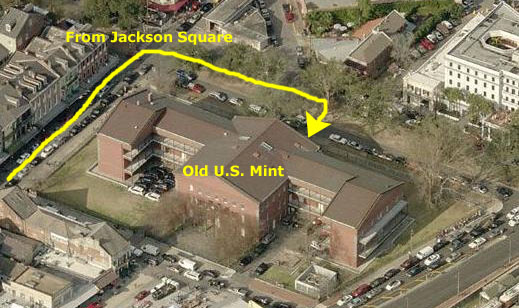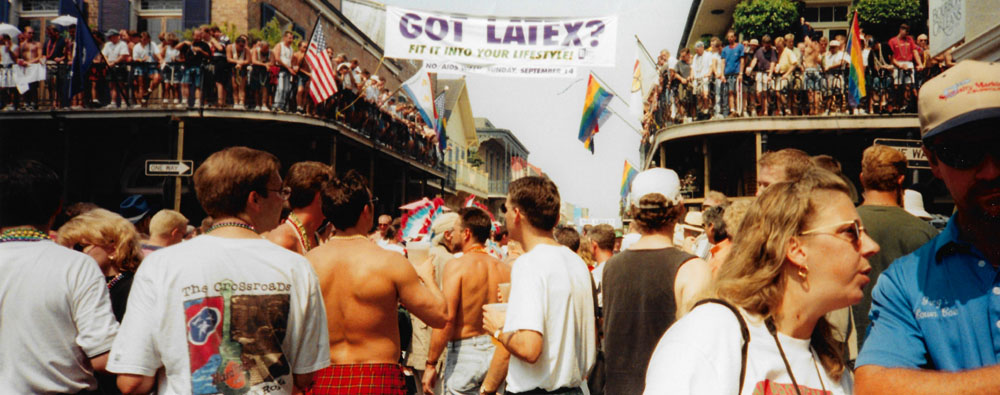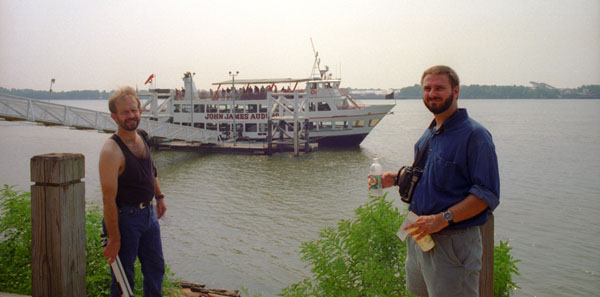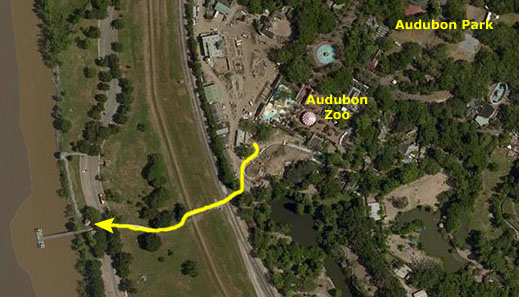


 |
October 4, 1997: Dallas Gay Pride Parade |
 |
August 9-10, 1997: A Trip to Austin |
 |
Return to the Index for 1997 |
Two years ago, Fred and I went with Lowery and Ron to Southern Decadence in New Orleans over Labor Day. Southern Decadence is kind of like a gay Mardi Gras, and we had a lot of fun. We decided to repeat this year, and this time stay in a rather more upscale place than we did two years ago. We flew down on Saturday morning (Lowery and Ron from DFW and Fred and I from Love Field), met at the New Orleans airport and took a cab into the French Quarter and our hotel.
|
Near the French Quarter, just off Jackson Square, we took a tour of the 1850 Building on Saturday morning. We also visited the Louisiana State Museum, located a bit further east from Jackson Square.
On Monday, Labor Day, we made a trip that we have done before. We took the St. Charles streetcar from the French Quarter out to Audubon Park and walked through that park to the New Orleans Zoo. We spent some time there and then walked to the Mississippi River where there is a dock for a riverboat the shuttles between the riverboat port downtown (near the French Quarter) and the port here near the Zoo. This trip not only allowed us to ride the famous streetcars and see the park and Zoo, but also to take a ride on the Mississippi River- very appropriate for New Orleans.
As far as the organization of this page is concerned, I'll organize these various activities in basically the order we did them.
The Royal Sonesta Hotel
|
The site of the Royal Sonesta New Orleans dates back to 1721 when French military engineer Adrien de Pauger first laid out the city of New Orleans. Originally, houses, courtyards and carriageways occupied the 300 block of Bourbon Street. During the 19th Century, Bourbon Street became a thriving commercial district with everything from a costume shop to a winery. In 1890, the American Brewing Company purchased the winery and expanded the building to encompass an entire city block. Nearly 70 years later, the owners of the Sonesta brand, the Sonnabends, were introduced to developer Lester Kabacoff and soon the site of the old brewery would be repurposed. In 1967, the Vieux Carre Commission approved plans to begin construction of what would become a landmark French Quarter hotel. Two years later, the Royal Sonesta New Orleans opened its doors.
The four of us went immediately to the hotel to check in when we arrived. Lowery and Ron wanted to relax in their room for a bit, so Fred and I went to have a look at the hotel and to wander out onto Bourbon Street. As was the case when we were here at this same time a few years ago, the weather was quite warm already.
The hotel is built in the old style, with all the rooms surrounding an inner courtyard. Here, they had done an excellent job of landscaping, such as it was, and Fred was intrigued by the water pool and water plants. He is in the process of building a smaller, less permanent version of this in his backyard.
After a while, we collected Lowery and Ron and went off to get some lunch at a diner that Lowery knew about, a few blocks away in the French Quarter. It turned out to be very busy, but very good. Also with a very heavy "family" clientele. After a nice breakfast, we walked out of the French Quarter down to Jackson Square and Clinton Street.
The Louisiana State Museum
|
 |
This mint, built under the direction of President Andrew Jackson in 1835, was the only U.S. Mint to ever mint under a flag other than that of the United States, as it briefly minted coins for the Confederacy. During its years of operation (1838 to 1861 and from 1879 to 1909), it produced over 427 million gold and silver coins of nearly every American denomination, with a total face value of over $307 million. It was closed during most of the American Civil War and Reconstruction.
After it was decommissioned as a mint, the building has served a variety of purposes, including as an assay office, a United States Coast Guard storage facility, and a fallout shelter.The building also served as a federal prison and a Coast Guard depot before becoming a branch of the Louisiana State Museum in 1981.
|
The Louisiana State Museum system has its beginnings in the Louisiana Purchase Exposition in 1904 at St. Louis, Missouri. A large number of pertinent artifacts were gathered to be displayed at Louisiana's exhibition at this fair. After the Exposition, it was decided that this collection should be stored, expanded, and displayed. The Louisiana State Museum was established in 1906 to fulfill this role. The Presbytere and the Cabildo buildings, located on either side of the St. Louis Cathedral on Jackson Square, were some of the first properties that the Louisiana State Museum was lodged in. The Louisiana State Museum now has thirteen properties around the state: historic structures, museums open to the public, and modern purpose-built buildings.
Over the past 100-plus years, the Louisiana State Museum has not only operated museums and maintained buildings, but it has served as the repository for all things historic from the state’s past. As Louisiana has been part of a French colony, a Spanish colony, Napoleon’s short-lived property, the United States' Louisiana Purchase territory, and finally the state of Louisiana; the Louisiana State Museum’s collections of artifacts and documents are an important asset for understanding state, national, and even global history.
|
We saw a wide variety of exhibits, including the Mardi Gras costumes, a permanent exhibit on the Mint's coining operations, exhibits on Louisiana music and the Louisiana Historical Center.
At left are two more of the pictures we took here inside the museum.
We stopped at the French Market on the way back to Jackson Square for a snack, and also walked over to the river for a while. Lowery and Ron went back to the Royal Sonesta while Fred and I continued walking around the area. Late that afternoon, Mike Racke arrived in town; he was on his way back from a business trip and checked into the hotel that afternoon.
We all had dinner together at a unique restaurant where the wait staff are drag queens- certainly an experience. And then, that evening, we did the normal strolling up and down Bourbon Street. Most people know about Mardi Gras; Southern Decadence is the gay version- with somewhat fewer costumes and parades and more drinking. There are quite a few bars down Bourbon Street, and that end of the avenue is like one gigantic block party. It’s always fun to see all the guys dressed up, trying to win bead necklaces tossed down from balconies above.
It was an enjoyable evening, but one that ended on a somber note. When we returned to our room and turned on the television, we learned that Princess Diana had been killed in an auto accident in Paris just hours before.
The 1850 House
|
The Baroness's father, Don Andres Almonester y Roxas, had rebuilt the Cabildo, Presbytere and St. Louis Cathedral on the northwest side of what was to become Jackson Square after the fire of 1788 destroyed the buildings previously on the sites, along with most of the old city. Micaela engaged noted local architects James Gallier, Sr. and Henry Howard to work on the design for the two rows of houses. While the designs were eventually completed, the business relationship between the three of them and her builder fell apart.
Because of this, the Baroness herself carefully and directly supervised much of the construction of her row houses. When the Pontalba Buildings were completed, each contained sixteen separate houses on the upper floors and self contained shops on the ground floors. The "A & P" cartouches that decorate the cast-iron railings signify the Almonester and Pontalba families.
Madame de Pontalba's buildings represent one of the first major American uses of industrially produced and nationally or internationally distributed building materials: New England granite, Baltimore pressed brick, English plate glass, English slates and roofing tiles, New York ornamental iron, New Jersey window glass, and Northern flagging.
|
William Ratcliffe Irby, a New Orleans philanthropist who was a pioneer in the preservation of historic landmarks in the French Quarter, bought the Lower Pontalba Building from the Pontalba heirs in 1921 for $68,000 and willed it to the Louisiana State Museum. In 1927, a year after Mr. Irby's death, the Museum came into possession of the building. The City of New Orleans ultimately acquired the Upper Pontalba Building on the opposite side of Jackson Square.
During the 1930s the Works Progress Administration, a federal job program, employed construction workers to do extensive restoration work on both Pontalba Buildings, and the town houses were subdivided into apartments. Restoration work on the Lower Pontalba Building continues to be an ongoing Museum project. In 1955 the Louisiana State Museum restored the interior of this building, #523 St. Ann Street, and the rooms of the second and third floors were furnished as examples of a fine town house in New Orleans in the 1850s.
The first floors of the Pontalba Buildings were divided into individual stores that were rented to both wholesale and retail dealers. The residential quarters above the stores generally were rented separately. The glass store fronts, an English innovation of the 1840s, admitted light and displayed goods to their best advantage. Today, one of these houses the Museum gift shop.
|
I would have liked to have gotten pictures of the interiors of the restored rooms in the 1950 House, but photography was only allowed outside, here on the back stairs of the house. Jackson Square is on the other side of the building, behind Lowery and Ron, and the stairs and walkway lead across an open area to what were originally servant's quarters.
Going through the 1850 House was very interesting, and I think everyone enjoyed it. The State Museum has done a great job with it. Now, we stopped for a snack in Jackson Square before heading back to the Royal Sonesta before going out again into the French Quarter for the Sunday afternoon and evening Southern Decadence festivities.
Southern Decadence
|
The event traces its beginnings to August 1972, at a party among a group of 40–50 friends. They billed their event as "Southern Decadence Party: Come As Your Favorite Southern Decadent." People who attended were required to dress as their favorite decadent Southerner. The first small "parade" occurred the following year, when the participants first met at a bar in the French Quarter to show off their costumes and then walk back home along Esplanade Avenue.
This first group impersonated people and characters ranging from Belle Watling (the prostitute character in Gone With the Wind) and Mary Ann Mobley to Tallulah Bankhead and Helen Keller. The event expanded, with the first Grand Marshal of the event appointed by members of the original group in 1974.
|
Decadence, as it is commonly known by participants, is marked by parades, bead tossing, street parties and dance parties. In these ways it resembles New Orleans Mardi Gras, however, Southern Decadence tends to be more sexual in tone and is generally geared towards more upscale and mature revelers. Decadence crowds in the Quarter typically match or exceed Mardi Gras crowds. Most events take place in or around the French Quarter neighborhood, centered at the intersection of Bourbon and St. Ann streets.
Crowds range from 100,000 to 200,000 revelers from across the nation and world; I believe that someone at the Hotel told me that the city expected some 180,000 this year. I learned later that the city estimates a positive economic impact of about $150 million each year from the event.
Here is a picture I took of Mike and Fred. Mike, like Fred, is a frequent photographer. Although I had my camera with me, I felt a little self-conscious taking many pictures of people who might not want to take the chance of being “exposed.” I guess this is really not a worry, since the chances of that happening (with almost everyone being from out-of-town) are slim to none.
Themes were presented on and off from the beginning, but did not become a consistent fixture of the event until "Circus Came To Town" theme in 1990. They have been featured every year that the Decadence has been held since then. They have ranged from themes as varied as "Voodoo That You Do", "Menage a Trois", "Ancient Truths, Lies, and Sacrifice", and "HURRICANE: This Year, They Blow Back." This year's theme, quite unintelligible to me, was "The Love Tour: A Wedding to Remember".
|
Decadence has always had its detractors because it is most a "gay" event. Even though New Orleans is probably one of the most cosmopolitan cities in the south, it is square in the middle of a very conservative state. But as yet, while there have been grumblings each year about the event, it seems that all the hotels, bars and businesses are solidly in favor of it- or at least willing to overlook any prejudices they might have in favor of the economic benefit they get.
Fred brought his panoramic camera here to New Orleans, but only took one panorama while we were here:
 |
Back at the hotel, we took a couple of pictures from the window of our corner room- this of the two buildings across the street- so typical of New Orleans. That night, all five of us went back out to Bourbon Street to continue people-watching. Mike disappeared early, saying that he really wanted to see if he could find a partner for the evening, so he set off on his own.
Audubon Park
|
I took a couple of other pictures here outside the hotel while we were waiting for Mike (who must've made quite a night of it) to meet us so we could head out, and I'll include them here even though they aren't that great (I think it was so humid that my camera lens was temporarily fogged). You can click on the thumbnail images below to have a look at them:
 |
Mike joined us and before we split up, Lowery asked him how his evening had been. He related his story of the night before, telling us he’d run into a really neat guy. Of course, Fred wanted to know all about him, so Mike began to describe the guy to us. The first three things he told us were (1) he was a bear, (2) he was from Ohio and (3) he was a Realtor. These three things instantly made me think of a fellow Grant and I had run into in Dallas ten years earlier, and my memory of his name didn't fail me. So, just for un, I said to Mike “You mean Doug Short?", the name I remembered from the late 1980s. Mike gave me a really strange look and said "How in the hell did you know?” What a coincidence! Mike was floored, and thought I was clairvoyant, when in fact I was just lucky that it was an amazing coincidence. I explained the whole thing to him, and I was sorry that he'd already gone; I would have liked to reconnect.
|
Just after we'd walked into the park, I got the picture you can see at right; the Spanish Moss and the huge trees made for a lovely setting. Audubon Park is located in New Orleans' Uptown neighborhood, about six miles west of the French Quarter. It is on land that was purchased by the city in 1871. It is bordered on one side by the Mississippi River and on the other by St. Charles Avenue, directly across from Tulane University and Loyola University. The park is named in honor of artist and naturalist John James Audubon, who began living in New Orleans in 1821.
The park was once a plantation, and used by both Confederates and the Union in the Civil War. The area was annexed by New Orleans in 1870, and the city purchased the parcel in 1871. It was intended as a park from the beginning, but first hosted a World's Fair and the Cotton Centennial of 1884. The only remnant of the fair still here is a large iron ore rock from the Alabama State exhibit (which in local lore has often been misidentified as a meteorite). Audubon Park's present form largely follows a design drafted by John Charles Olmsted, brother of Frederick Law Olmsted.
The park has been the site of such varied attractions as a golf course (1898-1930), a zoo, a miniature railway, the enormous Whitney Young public swimming pool, swan boats in the lagoons and a carousel. All save the zoo have long since closed. A more recent addition was a 2.2 mile dirt path around the perimeter of the park for runners.
The Audubon Zoo
|
The Zoo had its origins in the early 20th century; a flight cage dates from 1916. In the boom years of the 1920s many additions were made; two that remain are the sea lion pool with neo-classical columns from 1928 and the art nouveau reptile exhibit. During the Great Depression a WPA project expanded the zoo, with new cages and an artificial hill known as "Monkey Hill", built to show the children of flat New Orleans what a hill looks like and still the highest point in New Orleans.
By the early 1970s, the zoo was in a state of decay. The small prison-like brick and steel bar cages constructed by the WPA were no longer considered appropriate environments for many of the animals displayed in them. A study suggested that it should be closed down unless the city could make a major commitment to upgrade it. City government, local businesses, and private citizens did just that, and by the end of the decade, the Zoo was already well on its way to becoming one of the best in the country.
We didn't want to spend a great deal of time here at the Zoo; after all, New Orleans Southern Decadence isn't about the normal sights in the city. But we did take advantage of the low admission to go in and wander around.
|
In 1990, the Audubon Institute, which manages the zoo, opened the Aquarium of the Americas at the edge of the French Quarter. Some of the white alligators were transferred to there, and a riverboat began service taking visitors between the facilities. We visited the aquarium last time we were here last.
|
To view the slideshow, just click on the image at left and I will open the slideshow in a new window. In the slideshow, you can use the little arrows in the lower corners of each image to move from one to the next, and the index numbers in the upper left of each image will tell you where you are in the series. When you are finished looking at the pictures, just close the popup window.
When we were done at the Zoo, we again repeated something we'd done before- take the advantage of the shuttle boat that leaves from the dock at the Mississippi side of the Zoo and goes down the river to the dock at the New Orleans Aquarium. I think if you buy the admission to both facilities, the shuttle is free, but all we had to pay was a few dollars.
Our Mississippi Boat Ride
 At the River Shuttle Boat Dock |
 Walking to the River Shuttle Boat Dock |
In the picture above, you can see the s the boat we’re going to take. It has just docked and is getting ready to unload its current passengers.
|
We just took a couple more pictures on our way back to town. One looked back at the Metarie Bridges after we'd passed under them, and you can see that view here. And Fred took one picture of me as we came into the dock in town, and you can see that picture here.
Some Final New Orleans Pictures
|
The right-hand picture is of the east side of the square. There are shops on the ground floor of the row houses, and then either commercial or living space on the upper floors. In the plaza, vendors of all kinds set up shop all around the Square. There are artists, fortune-tellers, street performers and merchandise vendors of every description. It is a wonderful place to just walk around.
The last picture we took today was of some interesting wrought-iron scrollwork on a gate that Fred found interesting.
By late in the afternoon, we were back at the hotel. We had stored our stuff in Mike’s room, as he was staying on another night, so we got back together with Ron and Lowery and the four of us headed off to the airport for our flights home. Lowery and Ron flew to DFW, near their new house in Hackberry Creek, and Fred and I flew to Love Field. It was a great trip, both for the friends we were with and the sightseeing we did.
You can use the links below to continue to another photo album page.
 |
October 4, 1997: Dallas Gay Pride Parade |
 |
August 9-10, 1997: A Trip to Austin |
 |
Return to the Index for 1997 |